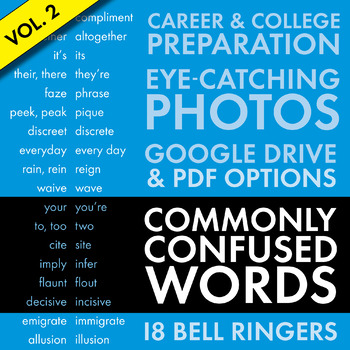Commonly Confused Words #2, Homophones, Slides + Note-Keeping Sheets CCSS
- Zip
- Google Apps™

What educators are saying
Description
Use these beautiful bell-ringer slides to grab your students’ attention at the beginning of class and teach them the right way to use 18 commonly confused sets of words/homophones. Each weekly lesson includes a photo slide prompting students to write a word usage rule (a great way to let you catch your breath and take attendance while they jot down notes) and then apply that rule to three different sentences. An answer key on a separate slide is also included with each week’s lesson. Materials provided in uneditable PowerPoint, Google Drive, and PDF format.
In addition to the three slide set for each Commonly Confused Words lesson (click the “Preview” button above: one slide has the photo and word usage rule; the next slide has three sentences for students to fix; the final slide is the answer key), you’ll also receive note-taking support handouts. One option is a note organizer for students to keep as ongoing lesson notes in their binders or interactive notebooks. A second option allows you to hand out a note-taking slip for students to complete and turn in to you for each session. (The second option could also work as a short reinforcement task later in the week or as a mini-quiz.)
This set was designed for grades 6-8, but would also work well for advanced English Language Learners/English as a Second Language students.
The commonly confused words/misused words in this Vol. 2 set of 18 bell-ringer lessons include:
complement/compliment
allusion/illusion
it’s/its
their/there/they’re
all together/altogether
faze/phase
waive/wave
discreet/discrete
everyday/every day
imply/infer
your/you’re
to/too/two
rain/rein/reign
peek/peak/pique
flaunt/flout
cite/site
emigrate/immigrate
decisive/incisive
Looking for another set of these bell-ringers?
Click here for Vol. #1 of Commonly Confused Words/Homophones
Click here for Vol. #3 of Commonly Confused Words/Homophones
Click here for Vol. #4 of Commonly Confused Words/Homophones
Need even more high-interest tools to help you smoothly launch class each day? Just click below:
• MUG Shots, Proofreading Warm-Ups to Teach Mechanics, Usage, and Grammar
• Literary Terms/Devices, 19 Mini-Lectures to Teach 45+ Terms
• Vocabulary, Word Work for College-Bound Students
• Brain Teasers, Puzzles and Fun Stuff to Build Logic, Word Sense, and Lateral Thinking
Thanks for stopping by!





